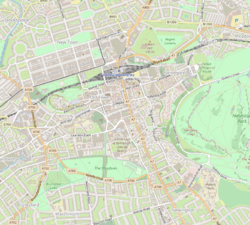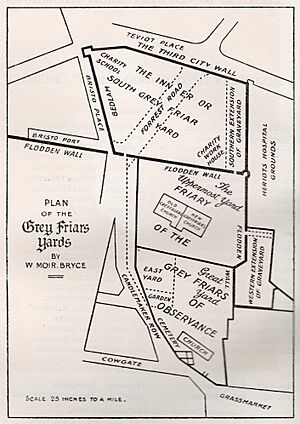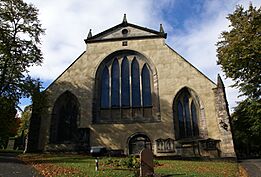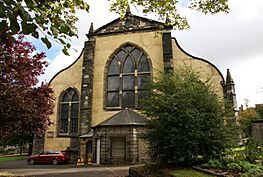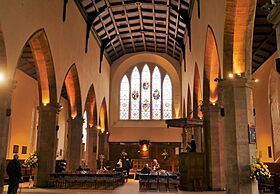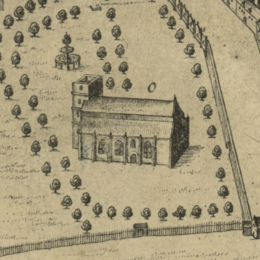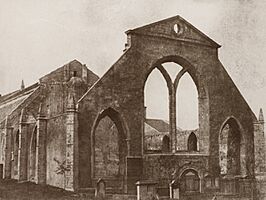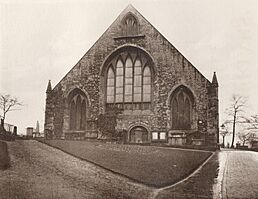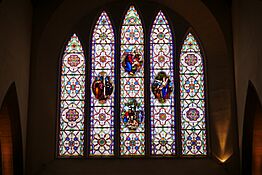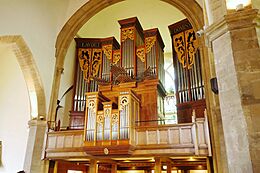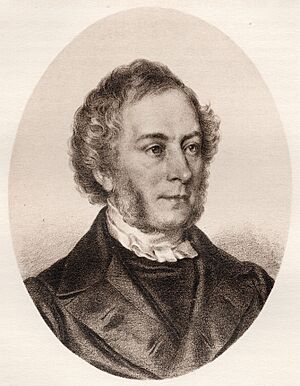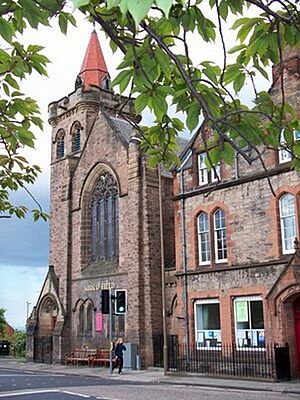Greyfriars Kirk facts for kids
Quick facts for kids Greyfriars Kirk |
|
|---|---|
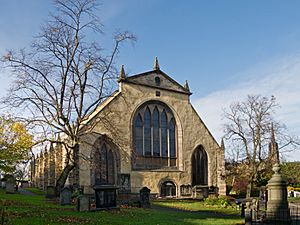
East end of Greyfriars Kirk
|
|
| 55°56′48″N 3°11′32″W / 55.9466°N 3.1922°W | |
| Location | Old Town, Edinburgh, Scotland |
| Country | Scotland |
| Denomination | Church of Scotland |
| Website | [1] |
| History | |
| Former name(s) | Greyfriars, Tolbooth, and Highland Kirk (1979-2013) |
| Status | Parish church |
| Founded | 1620 |
| Architecture | |
| Functional status | Active |
| Heritage designation | Category A listed building |
| Designated | 14 December 1970 |
| Architect(s) | Clement Russell, Patrick Cochrane, Alexander McGill, David Bryce, David Cousin, Henry F. Kerr |
| Style | Gothic, Baroque |
| Groundbreaking | 1602 |
| Completed | 1620 |
| Specifications | |
| Length | 162 feet (49 meters) |
| Width | 72 feet (22 meters) |
| Administration | |
| Presbytery | Edinburgh |
Greyfriars Kirk (which means "Church of the Grey Friars" in Scottish Gaelic) is a parish church in Edinburgh, Scotland. It belongs to the Church of Scotland. The church is in the city's Old Town. It is surrounded by a famous old graveyard called Greyfriars Kirkyard.
The church gets its name from the "Grey Friars." These were Franciscan monks who wore grey robes. They came to Edinburgh in the 1400s. They had a monastery (a place where monks live) on the land where the church now stands. After the Scottish Reformation (a big change in religion in Scotland), the monastery was abandoned. The land was then used as a cemetery. The church you see today was built there between 1602 and 1620.
Greyfriars Kirk has seen many important events. In 1638, the National Covenant was signed here. This was an important document for Scottish religious freedom. The church was also used as barracks by soldiers in the 1650s. In 1718, an explosion damaged the church. It was then split into two separate churches, "Old Greyfriars" and "New Greyfriars." A fire in 1845 damaged Old Greyfriars. After it was rebuilt, new features like a pipe organ and stained glass windows were added. This was a big change for Scottish churches at the time. In 1929, the two churches reunited.
Today, Greyfriars Kirk is known for its community work. It helps people through projects like the Grassmarket Community Project. The church also holds weekly services in Scottish Gaelic, continuing a long tradition.
Contents
History of Greyfriars Kirk
The Grey Friars in Edinburgh
Catholic monks called "Observatine Franciscans" first arrived in Scotland in 1447. They were invited by King James I. These six monks came from the Low Countries (modern-day Netherlands). They settled in Edinburgh around 1453 or 1458.
The monastery was supported by the royal family. It even hosted Mary of Guelders, a queen, in 1449. Henry VI of England also found shelter there during his exile. King James IV was very close to the Edinburgh Grey Friars. He even called himself their "Royal Protector." By the mid-1500s, about 50 to 60 monks lived there.
In 1558, the monastery was affected by the Scottish Reformation. Reformers stole a statue from a nearby church. The Grey Friars lent their own statue for a procession. But Reformers damaged it. In 1559, a mob attacked the Friary. The monks had to hide. Most of Scotland's Franciscan monks, including those from Edinburgh, left the country in 1560.
Building the Church
By 1565, all the monastery buildings were gone. Their stones were used to build other parts of the city. The graveyard of St Giles' was too full. So, in 1562, Mary, Queen of Scots gave the monastery's land to the city council. It was to be used as a burial ground.
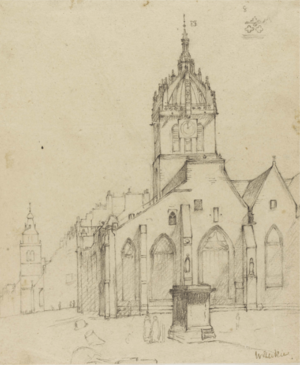
The Greyfriars congregation started in 1584. The city council decided to divide Edinburgh into four parishes (church areas). A new south-west parish was created. It was meant to meet in St Giles'. This plan was put into action in 1598.
By the late 1500s, St Giles' was too small for Edinburgh's growing population. In 1601, the council decided to build a new church. It would be in the southern part of the Greyfriars burial ground. Construction began in 1611. Materials from another monastery were used. Timber for the roof came from Sweden in 1612.
The Kirk was first used on February 18, 1619, for a funeral. Regular church services began on Christmas Day 1620.
Covenant and Conflicts
In 1637, King Charles I tried to force a new prayer book on the Church of Scotland. This caused a riot at Greyfriars on July 23. People in the congregation argued with the minister.
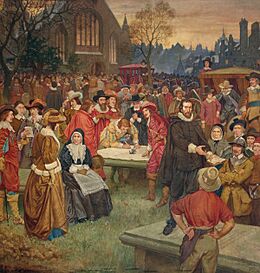
This resistance led to the National Covenant. This important document was first read from the pulpit of Greyfriars. Then, Scotland's nobles and gentry signed it inside the church. Copies were taken around Edinburgh for many more people to sign. This led to wars.
In 1650, Oliver Cromwell's troops took over Edinburgh. They used Greyfriars church as a barracks for cavalry (soldiers on horseback). This caused a lot of damage. Cromwell himself might have preached there. In 1656, the church was divided by a wall. This was for two new parishes, but it was removed in 1662.
After the king was restored in 1660, the church faced more changes. Presbyterianism (the way the Church of Scotland is run) was challenged. This led to more conflict for the Covenanters. Many were imprisoned in a field next to the kirkyard in 1679. After the Glorious Revolution, Presbyterianism was restored.
Damage and Rebuilding: 1718-1843
From 1706, the city council used the church tower as a gunpowder store. On May 7, 1718, it exploded. The explosion destroyed the tower and badly damaged the west end of the church. The congregation met in other places while repairs were made.
Alexander McGill oversaw the repairs. A new wall was built to enclose the eastern part of the church. Two new sections were added to the west end. This created a church divided into two equal halves. The work finished by 1722. The costs were paid by a local tax on ale. The western half became "New Greyfriars." The original congregation met in the eastern half, known as "Old Greyfriars."
In 1840, a new church, St John's, was formed from Old Greyfriars parish. In 1843, many people left the Church of Scotland in an event called the Disruption of 1843. The minister of Old Greyfriars left to join the Free Church.
Fire and "Greyfriars Revolution"
On January 19, 1845, a fire broke out in Old Greyfriars. It destroyed the inside of Old Greyfriars and damaged New Greyfriars. Because it happened soon after the Disruption, some people thought it was a sign from God. The city council, many of whom had joined the Free Church, made the restoration difficult. It took twelve years to rebuild.
During the rebuilding of Old Greyfriars, the minister, Robert Lee, asked for stained glass to be installed. This was the first coloured glass in a Church of Scotland building since the Reformation. After the church reopened in 1857, Lee started what was called "the Greyfriars Revolution." He introduced new ways of worship. These included standing for hymns, kneeling for prayers, and using prepared prayers. These were new ideas for Scottish Presbyterianism. Lee also added a harmonium in 1863 and a pipe organ in 1865. Lee's ideas greatly influenced how Presbyterian services are held today.
20th and 21st Centuries
In 1929, Old and New Greyfriars churches reunited. From 1932 to 1938, the whole church was restored by Henry F. Kerr. The wall that divided the two congregations was removed. In 1938, another church, Lady Yester's Kirk, joined Greyfriars. In 1941, the New North Church also joined.
In 1979, the congregation of Highland, Tolbooth, St John's united with Greyfriars. The new church was called "Greyfriars, Tolbooth, and Highland Kirk." Since this union, Greyfriars has continued to hold regular Gaelic language services.
In the 1990s, a church museum was created. It was updated in 2012. In 2013, Kirk o' Field Parish Church united with Greyfriars. The church went back to its original name, "Greyfriars Kirk." Since 2016, the former Kirk o' Field buildings have been used as the Greyfriars Charteris Centre.
Church Building and Graveyard
Greyfriars Kirk is located within Greyfriars Kirkyard. This graveyard is bordered by the Grassmarket to the north and Candlemaker Row to the east. This is the same land given to the Franciscan monks in the 1400s. It was then on the edge of the Old Town.
The southern and western walls of the monastery grounds were strengthened between 1513 and 1515. They became part of the Flodden Wall, which protected the city. When the burial ground was created in 1562, a gate was added. This gate is where the current north gate of the kirkyard is.
Architecture and Design
What the Church Looks Like
The church is shaped like a rectangle. It has a single main area (called a nave) with eight sections (called bays). There are also side areas (called aisles) along the whole length of the church. The building style is a mix of "Survival Gothic" and Baroque. Gothic style continued even after the Scottish Reformation.
The outside walls are made of rough stone covered with harling. The church is about 162 feet (49 meters) long and 72 feet (22 meters) wide. On the outside, each section is divided by buttresses. These are supports that help hold up the walls. Each buttress has a ball-topped obelisk on top.
Most sections have a window. Many of these windows have been made larger. The western windows on the north side and the westernmost window on the south side are simple lancet windows. These are tall, narrow windows without fancy patterns. Other windows have more complex patterns.
On the north side, there are two round-arched doorways. Above one of these is a stone carving of the arms of Edinburgh. These north doors are covered by a large, fancy Palladian porch. This porch has three sections and two levels. The ground level has round-headed arches. The upper level has three rectangular windows.
The east end of the church has a Classical pediment (a triangular shape at the top). It has small ball-topped decorations. The main window is round-arched with five lancet lights. A stone marked "1614" with Edinburgh's arms is below the pediment.
The west end of the church has a Dutch gable (a decorative stepped shape). It also has a pediment similar to the east end. The central window is a large lancet with three lights. Below this window is a small, semi-octagonal Renaissance-style porch.
Inside, octagonal pillars support parallel arcades (rows of arches). These run along all eight sections. The western two sections have a plaster vaulted ceiling. This area is separated by an arch and holds the organ loft. The eastern six sections have a timber barrelled ceiling. This ceiling is supported by wooden shafts. Each arch has a decorative boss (carved ornament) showing symbols like Saint Andrew and the Trinity.
How the Church Changed Over Time
The church building started around 1602. Clement Russell was the "master of work." Stones from another monastery were used for its construction. The church officially opened in 1620.
When finished, the church had six sections with side aisles and a square tower at the west end. It also had galleries (balconies) on the east, west, and probably north sides. The church was damaged when Oliver Cromwell's English Army used it. It was later repaired. Greyfriars was the first church built in Edinburgh after the Reformation. It was also the largest post-Reformation church in Scotland for a long time.
Rebuilding After 1718
On May 2, 1718, the gunpowder stored in the tower exploded. This destroyed the tower and badly damaged the church. The city council quickly enclosed the eastern four sections with a new wall. Galleries were added to make up for lost space. The old north door was moved. In 1719, Alexander McGill was hired to build a new church in the western half. He added two new sections to the west. This created two separate churches: Old Greyfriars (East) and New Greyfriars (West).
McGill added a Dutch gable and a Classical pediment to the west end. He also added the semi-octagonal porch. He made the east end look similar. In 1722, McGill added the large Palladian north porch.
Repairs After 1845
On January 19, 1845, a fire destroyed the inside of Old Greyfriars. It also damaged New Greyfriars. David Bryce designed new furnishings for New Greyfriars. It reopened in 1846.
The rebuilding of Old Greyfriars took twelve years. David Cousin completely rebuilt Old Greyfriars in 1856 and 1857. He added "Early English" lancet windows. He also created a simple, triangular gable at the east end. The arches inside were not rebuilt. This left an open space with a single timber ceiling. Cousin's work was praised at the time.
Changes from 1932 Onwards
The church's current look comes from a restoration between 1932 and 1938. This was led by Henry F. Kerr. Kerr removed the wall that divided the two churches. He rebuilt the arches in the eastern four sections. He kept the plaster vaulted ceiling in the western two sections. Over the other six sections, he installed a barrelled ceiling made of California redwood. In 1989, a new organ loft was added.
Kerr also changed the roof over Old Greyfriars. He recreated the pediment over the eastern gable.
Special Features
Stained Glass Windows
The windows in the eastern four sections of the church are the oldest stained glass windows in a Church of Scotland building. They were added in 1857 by Robert Lee. They were the first coloured windows in a Scottish church since the Reformation. Most of these windows have abstract patterns. But the east window shows scenes like the Prodigal Son. These windows remember important people like John Erskine and William Robertson.
Further west, the Saint John the Baptist window was moved here in 1979. Another window by Marjorie Kemp remembers Helen Pearl Gardiner. It shows Saint Helen and Saint Margaret. The main window at the west end shows the morning of the Resurrection. A special millennium window with a Celtic cross was added in 2000.
Organs
The main organ is at the west end of the church. It was built in 1989 and has almost 3,400 pipes. The organ cases have carvings of Scottish plants and animals. There is also a carving of a Franciscan Friar and Greyfriars Bobby. A phrase from Psalm 150 is carved on the organ: "Let everything that hath breath praise the Lord." A smaller chamber organ is in the north aisle.
The first organ in Greyfriars was a harmonium. It was installed in 1863 during Robert Lee's time. This was the first successful attempt to use an organ in a Church of Scotland building. The harmonium was replaced by a larger pipe organ in 1865. This organ was later rebuilt and enlarged.
Memorials
Margaret, Lady Yester, who helped found Lady Yester's Kirk, is remembered by a 17th-century plaque. This plaque was moved from Lady Yester's Kirk in 1938. Her headstone was found in 1951.
John Hutchison created a marble memorial to Robert Lee in 1870. It includes a portrait of Lee. Hutchison also made a plaque for William Robertson. A stone tablet for Robert Adam was added in 1992. Other people remembered by plaques include Thomas Ruddiman and Walter Scott.
Furnishings
The dais (raised platform), oak wainscot (wooden paneling), and communion table at the east end were added in 1912. The table has bronze panels showing symbols of the four Evangelists. The wainscot has carvings of the wounds of Christ.
Herbert Honeyman designed the Jacobean-style canopied pulpit. It has the arms of Scotland, Edinburgh, and the University of Edinburgh. In 1951, the pulpit was moved to its current position. The church also has brass and oak eagle lecterns. The oak lectern came from Lady Yester's Kirk.
The font was brought from Rome in 1912. It is likely from the early Renaissance. The communion tables from the New North Church and New Greyfriars are also in the church. The wooden pews in the main area were replaced by chairs in 1989.
Bells and Artefacts
The bell of Greyfriars hangs outside the north porch. It was made in the 1860s and given to Greyfriars in 1991. The first bell of Greyfriars was installed in 1684. This bell was destroyed in the 1718 explosion.
Greyfriars has several old communion cups, some from 1633 and 1644. It also has cups donated to Lady Yester's Kirk in 1708. There are also pewter alms dishes from the 1700s.
Important historical items are on display. These include an original copy of the National Covenant. You can also see Robert Traill's sword and an 1867 portrait of Greyfriars Bobby. A U.S. flag hangs in the north aisle. It was given in 1970 to celebrate the 350th anniversaries of the Pilgrims landing and Greyfriars opening.
Church Life and Mission
Ministers and Leaders
Richard Frazer has been the minister of Greyfriars since 2003. He became a minister in 1986.
Both Old and New Greyfriars were "burgh churches." This meant the city council chose their ministers until 1874. Old Greyfriars used to have two ministers until 1840. New Greyfriars always had one minister. Many ministers of New Greyfriars were later promoted to other churches.
Three ministers of Old Greyfriars became Moderator of the General Assembly (the head of the Church of Scotland). These were George Kay in 1755, William Robertson in 1763, and John Inglis in 1804. Two ministers of New Greyfriars also became Moderator. In 2003, Alison Elliot, a church elder from Greyfriars, became Moderator. She was the first woman and the first non-minister to hold this role since 1567.
Community Work
Since the 1700s, Greyfriars has been involved in community work. New Greyfriars was very active in this. It founded the Vennel Ragged School in 1846, one of the first of its kind in Edinburgh. In 1886, the congregation built the Robertson Memorial Mission in the Grassmarket.
Since 1982, the church has worked with the Grassmarket Mission. Together, they created the Grassmarket Community Project. This project helps homeless people and those with health needs. Since 2016, Greyfriars Kirk has also run the Greyfriars Charteris Centre. This centre offers halls for the local community.
In 2002, Greyfriars Kirk joined with two other churches. They agreed to work together to have a strong Christian presence in Edinburgh. They hold joint services during Holy Week.
The minister of Greyfriars is part of the chaplaincy team at the University of Edinburgh. The church also hosts services and events with the university.
Worship and Music
Greyfriars' main service is every Sunday at 11 a.m. Communion is held once a month. A prayer service takes place every Thursday.
Greyfriars played a big role in changing how services were held in the Church of Scotland. During Robert Lee's time, new practices were introduced. These included standing for hymns, using prepared prayers, and playing a harmonium. Lee's ideas led to the creation of the Church Service Society.
Greyfriars has a mixed, non-professional choir. They sing at the Sunday services and special events. The choir is led by Henry Wallace. Choral music at Greyfriars began in 1865.
Gaelic Services
A Gaelic language service is held every Sunday at Greyfriars at 12:30 p.m. Ministers and preachers from different churches lead these services. The services also feature unaccompanied singing of Psalms. The church also hosts an annual lecture on Gaelic topics.
Gaelic services have been held at Greyfriars since 1979. This was when the church united with Highland, Tolbooth, St John's. Gaelic worship in Edinburgh started in 1704. This was for Gaelic-speaking soldiers at Edinburgh Castle.
See also
 In Spanish: Greyfriars Kirk para niños
In Spanish: Greyfriars Kirk para niños


